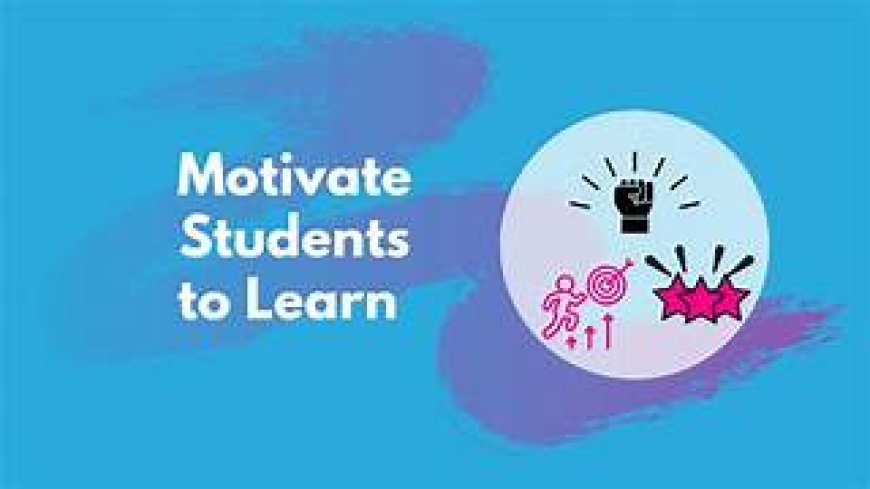10 Easy Ways to Motivate Uninterested Students
Discover 10 effective ways to motivate students who don’t want to learn, using engaging strategies to inspire curiosity and boost participation.

Every teacher has faced a student who seems disinterested in learning. It can be frustrating, but understanding why a student lacks motivation is the first step to helping them. Some students struggle with personal challenges, while others find traditional teaching methods unengaging. The key is to make learning meaningful and relevant to their lives.
Encouraging students requires patience, creativity, and a deep understanding of their interests. Here are ten practical strategies teachers can use to inspire reluctant learners and turn their classroom into an exciting place for education.
1. Build a Positive Relationship with Students
Students are more likely to engage when they feel respected and valued. Teachers should take time to understand their students' interests, strengths, and struggles. A warm greeting, a friendly chat, or showing interest in their hobbies can create a bond of trust. When students feel safe and supported, they are more willing to participate in learning.
2. Make Learning Relevant to Their Lives
Many students disengage because they don't see how their lessons apply to real life. Teachers can bridge this gap by connecting lessons to everyday experiences. For instance, a math teacher could relate statistics to sports scores or budgeting. Science lessons can be tied to current environmental issues. When students see the real-world value of what they’re learning, their interest grows.
3. Use Interactive and Hands-On Activities
Sitting through long lectures can be dull, especially for students who struggle with attention. Instead of traditional teaching methods, educators can incorporate group activities, experiments, role-playing, and educational games. These interactive methods keep students engaged and make learning more dynamic.
4. Encourage a Growth Mindset
Some students avoid learning because they fear failure. Teachers should emphasize that intelligence is not fixed and that effort leads to improvement. Praising hard work and perseverance instead of just results helps students develop resilience. Using phrases like "You're improving!" or "Mistakes help us learn" can encourage students to keep trying.
5. Offer Choices and Autonomy
Students feel more motivated when they have a say in their learning. Giving them options—such as choosing a project topic, selecting a book to read, or picking a method to complete an assignment—can boost their sense of ownership. When students feel in control, they take greater responsibility for their education.
6. Incorporate Technology and Multimedia
Today's students are digital natives who respond well to technology-based learning. Teachers can use videos, podcasts, interactive apps, and online quizzes to make lessons more appealing. Virtual field trips, coding challenges, and educational YouTube channels can also bring subjects to life in ways that traditional textbooks cannot.
7. Set Small, Achievable Goals
Large tasks can be overwhelming, leading students to give up before they even start. Breaking lessons into smaller, manageable goals gives students a sense of accomplishment. Teachers can set daily or weekly objectives, allowing students to track their progress and stay motivated.
8. Provide Constructive Feedback and Rewards
Encouraging words can go a long way in boosting a student’s confidence. Instead of focusing only on mistakes, teachers should highlight progress and effort. Simple rewards like certificates, stickers, or classroom privileges can also encourage participation. However, intrinsic motivation—helping students feel proud of their progress—is the ultimate goal.
9. Create a Supportive and Encouraging Environment
A classroom should be a place where students feel safe to express their thoughts without fear of judgment. Encouraging peer support, promoting teamwork, and fostering an inclusive atmosphere can make students more comfortable with learning. Teachers can also identify students who need extra attention and provide personalized support.
10. Be Patient and Keep Trying Different Approaches
Not every strategy works for every student. Teachers should be flexible and willing to try different methods until they find what resonates. Some students may respond to storytelling, others to competition, and some to hands-on activities. The key is to remain patient, adaptable, and persistent.
Conclusion
Motivating reluctant students is not about forcing them to learn but about making learning enjoyable and meaningful. By building relationships, using interactive methods, and fostering a growth mindset, teachers can unlock a student’s potential. Every child can succeed with the right support, encouragement, and approach. Education is not just about lessons—it’s about inspiring a love for learning that lasts a lifetime.




























